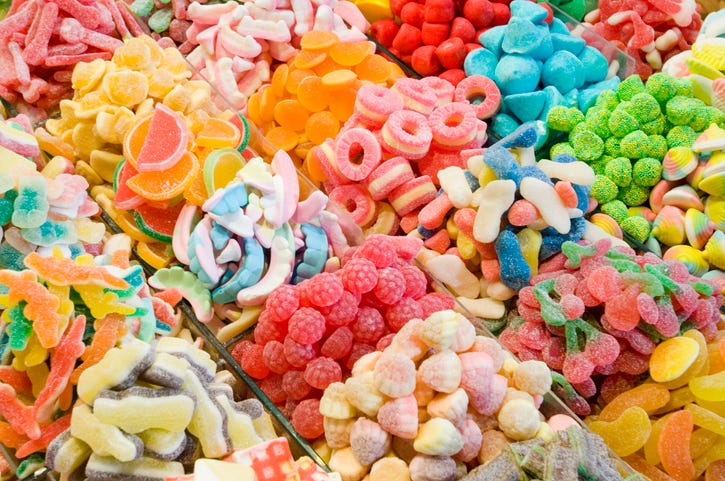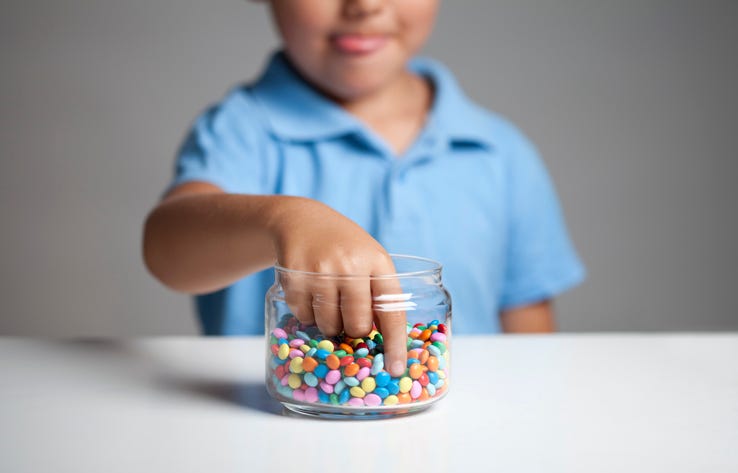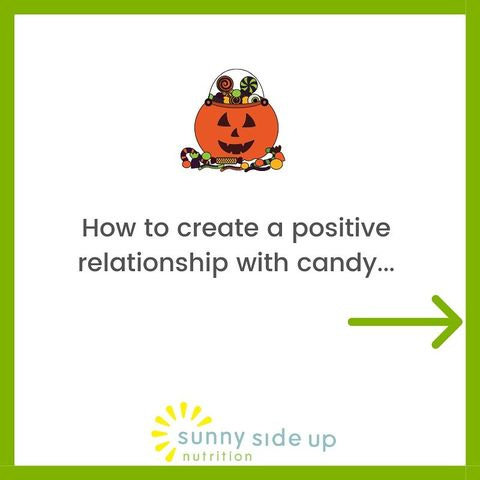The Burnt Toast Guide to Kids & Sugar
Everything you need to know about sugar highs, sugar addiction, and Halloween candy.
ICYMI, BT Guides are a new recurring series where I dig into your most frequently asked questions. Here’s the first, on weight and health, the second, on talking to kids about anti-fat bias, and the third, on diet culture in schools.
BT Guides are a free resource, but if you find them valuable, please consider supporting this work with a paid subscription. You can join for just $5 per month (or $50 for the year).
Or you can upgrade to our new Extra Butter tier for $10 per month.
Extra Butters are going to get everything that comes with the usual paid subscription plus a monthly Live AMA thread with me. Our next one will be tomorrow, Wednesday October 11, from 8-9pm EST! We can talk about diet culture, anti-fatness, divorce, fat fashion, gardens… I’ll answer as many Qs as I can in the hour, plus everyone chats amongst themselves too. It’s the best.
If you can’t make it (I get it, time zones!) but have a question to ask, you can drop it here and catch up on the thread later. You can also check out last month’s thread to see if this will be your jam. (Clearly biased but it was VERY MUCH MINE, you all are a blast to hang out with.) Extra Butters will also get a bonus Indulgence Gospel every month and other fun stuff tbd. Join now so you don’t miss out!
PS. If you were already a “founding member,” you’ve been automatically converted to Extra Butter status! Comp subscribers, I’m still working on how to get you all access to Extra Butter content—stay tuned.

But What About Sugar?
Last week, we met some friends at a local playground. As the kids ran off, one of the moms brought out a box of pastries she’d picked up for us to share. “Are you still doing your fasting thing?” she said to one of the dads, who nodded and sighed. Suddenly nobody—except me!—was reaching for a croissant. The box of sugar sat on the picnic table in front of us like a bomb nobody wanted to defuse.
Anytime I take my kids to a playground, a birthday party, or any activity that will combine snacks and other parents, I find myself bracing for what I call The Moment. The Moment is when an adult will say something anti-sugar, usually within earshot of children. These comments are usually quite well-intentioned: Parents and caregivers tend to believe fervently in the existence of sugar highs, despite all scientific evidence to the contrary. (More on that in a minute.) Parents and caregivers have been told that our job is to teach kids to “eat healthy,” and we interpret that to mean “as many fruits and vegetables as possible, whatever the cost.” And we live in a culture that informs us, early and often, that sugar is the worst thing we could let our children eat.
None of this is true.
Demonizing sugar to children both overstates its potential health risks and increases the likelihood that they’ll develop the kind of fraught relationship with treats that can lead to disordered eating and eating disorders.
I’m publishing this guide very deliberately a few weeks before Halloween, because this coming season—from trick-or-treating on through the winter holidays—tends to be especially laden with treat-related anxiety, until we crash land in January. (Don’t worry, we’ll do a special January Diet Culture Guide then!) But the framework we’ll discuss here can be applied to all sorts of high treat scenarios, any time of year. It may also help you rethink how you and your family interact with sugar on any given day.
The Big Lie: Sugar Gets You High
So about those sugar highs. Here’s what I learned when I reported a2020 New York Times article called “Sugar is Not The Enemy:”
The theory that sugar intake could lead to what was then called “the neurotic child” was first proposed in the medical literature in 1922 and later gained popularity during the 1970s, when researchers were first trying to understand and treat attention deficit hyperactivity disorder.
[...But] the sugar high concept was decisively debunked by a double-blind, controlled study published in the New England Journal of Medicine in 1994. In that experiment, researchers recruited a mix of normal preschoolers and those whose parents described them as sensitive to sugar, then randomly assigned some kids to eat sugary food and others to eat foods sweetened with aspartame. (Nobody — including parents, kids and researchers — knew which child ate what.) No behavioral or cognitive differences were detected, and as Dr. Richard Klasco, M.D., reported in The New York Times’s “Ask Well” column, these results have been replicated in several subsequent studies.
But how to square this scientific reality with parents’ impressions of how sugar affects their children? “Our brains and bodies can feel a burst of energy after eating sugar, especially if it’s been awhile since we’ve eaten and we’re feeling low on energy,” explained Anna Lutz, M.P.H., R.D., a dietitian in private practice in Raleigh, N.C. “That’s because table sugar is a simple carbohydrate that breaks down quickly in our digestive tract, to reach our bloodstream.” But that quick burst doesn’t translate into hyperactivity or tantrums.
I share this research not to deny the experience of anyone who has noticed their child’s behavior changing soon after eating sugar. But because it’s worth considering the context for that behavior: Are they at a birthday party or other highly stimulating event where emotions would be running high no matter what? Are they hearing parents make a lot of anti-sugar comments? Are you getting tenser as they get more icing-covered? Kids know when they’re eating in ways they know we won’t like. This can make them more frenetic about eating a lot of that food, or more anxious that they’ve eaten too much. And then our expectations are met, and the cycle is doomed to repeat itself.
Birthday parties aren’t the only place kids pick up on our sugar fears. When we require kids to eat their lunch in a certain order (treats last!) or tell them they have to finish their main meal in order to earn dessert, we are quite literally rebranding “treats” as forbidden fruit. But scientific research has known for years that this will backfire. Being told they have to “earn” certain foods makes kids want them more, and makes them much less excited about the salad we tell them to slog through first. And because these messages are so pervasive, it’s virtually impossible to study the physiological impact of sugar on humans alone. Our emotional responses to sugar—learned in early childhood and reinforced ever since by diet culture—are always coming into play.
That’s why the sugar high myth also helps to pave the way for the sugar addiction myth, which we apply to both kids and adults. As I explain in Chapter 7 of Fat Talk:
It’s not that delicious food has no impact on our brains—but it doesn’t induce [a] total lack of control in the way most people think. “Eating pleasurable food does induce a dopamine response,” says Sumner Brooks, MPH, RDN, an eating disorder dietitian in Portland, Oregon and co-author of How To Raise an Intuitive Eater. Dopamine is also known as the “feel good” hormone. It surges in our brains whenever we experience pleasure, and defenders of the sugar addiction model cite this as evidence because the sugar-dopamine response can look like the response seen in the brains of people using narcotics. But we also get dopamine responses from purely benign activities like seeing a puppy, hugging a loved one, or feeding our babies. [...]
We don’t tend to crave straight sugar, eaten from the bag with a spoon; we are more often drawn to foods that provide a combination of sugar, fat and salt because they offer us a certain blend of taste, texture, and mouthfeel. “These foods feel rewarding and can induce strong cravings for many reasons, the most common of which is deprivation,” says Brooks. That deprivation can be physical; because our bodies require glucose for survival, we will crave carbohydrates when we aren’t getting enough of them. But this isn’t addiction, at least, not any more than craving water when you are thirsty makes you a hydration addict. Sugar deprivation can also be psychological: “People who have been restricted, [have] dieted, or [have been] food insecure in the past may experience a constant looming emotional threat of deprivation, which makes their drive to eat sugar even more intense,” Brooks explains. [...]
When researchers study sugar addiction in rats—creatures without diet culture—they can only show rats engaging in addictive behaviors (eating huge quantities, or compulsively and repeatedly pressing a lever to make more food appear) with sugar if they first inflict a diet upon them. Restriction breeds fixation.

So What Should We Do Instead?
1. Embrace Habituation
OK, so you can see how restriction backfires. What’s the solution? Habituation, which psychologists define as “the diminishing of a physiological or emotional response to a frequently repeated stimulus.” Contrary to what every diet influencer has ever told you: The more sugar we eat (freely, without guilt or atonement), the less frantic we feel about eating sugar.
I love how
explains habituation in this piece:A helpful example is when you go to a new city, you’re hyper aware of the sounds and noises that are unfamiliar; the people talking on the street, the ambulances and planes flying overhead. But after you’ve been there for a while it all blends together into background noise. [...] giving sweets more frequently makes them a bit less shiny. Kids are always going to be interested in sweets. Habituation doesn’t mean that they will never want sweets, and if that’s the goal of this work, then we need to talk.
Habituation just means that sweets keep their place as one part of our food life. If we offer sweets infrequently, we limit kids' choice as to whether they take it or leave it. They will only ever take it because it’s never available. When we offer sweets often, it opens up a bit more space for kids to tune into whether they actually want it, or if they are only taking it because it's there.
I’m personally seeing habituation in action in my pantry right now, where a giant tub of M&Ms has been sitting, three-quarters full, for about a month. One of my kids was on a real M&M kick over the summer and would pour herself cereal bowl-sized servings at snack time. But after a few weeks of M&M adoration, she habituated. She still enjoys a handful here and there. But the fixation phase passed quickly because she wasn’t restricted. Indeed, I expected her initial fixation because I bought M&Ms on a whim after not having them in the house for a few months (because we’d all lost interest awhile back). The novelty of bringing them back sparked an initial “obsession.” But once she remembered she could rely on them being generally available, she relaxed.
Habituation seems to be an innate human skill, related to our internal hunger, fullness and satiation cues. So you don’t have to teach your kid to habituate; you mostly just have to get out of their way. But remember that restriction can be clear-cut (having a “no candy” rule in your house). But it can also be far subtler: Maybe you buy the M&Ms but regularly count out your kids’ servings or have a “Sugar is for Saturdays” rule. Maybe you casually refer to all candy or other sugary treats as “junk” or talk about “being bad” when you eat them. All of this can create a culture of restriction that may trigger kids’ scarcity mindsets around certain foods even if they get to eat them pretty often.
If your kids still seem hyper-fixated on sugar even after you start serving it more often, evaluate whether your family’s larger food culture might contain some of these less overtly restrictive messages. And be patient with everyone if this is new. If you’ve just lifted a longtime sugar ban, of course your kids are eating more right now. They haven’t habituated yet! And to do that, they need to trust that you aren’t going to change the rules again.
2. Use Structure to Support Body Autonomy
When I talk about my kids sometimes eating a cereal bowl-full of M&Ms or multiple types of orange snack crackers, people often assume this means our house is a lawless wasteland where the children raise themselves on red dye and high fructose corn syrup. I mean, it doesn’t sound horrendous, but it’s definitely not what’s happening.
As I’ve written before, I subscribe to the basic tenets of Ellyn Satter’s Division of Responsibility, which puts parents in charge of when meals happen, where they happen, and which foods get served, while leaving kids in charge of how much they eat and which foods they eat from what we’ve offered.
In addition to the overall meal framework, many families who do well following Satter’s standard dessert advice, which is to include one serving (say, a couple of cookies) alongside main meals. Satter argues that this approach neutralizes treat foods, because kids have regular access. She also encourages parents to plan other opportunities when kids can eat as many cookies or other treats as they want in one sitting, so kids also have the opportunity to experiment for themselves with the “how much” part.
After years of interviewing dozens of families (and hearing via comments, DMs and emails from hundreds more), I’ll say: Your mileage may vary. Laura Thomas notes the inherent anti-fatness of the “one serving” rule here. Nevertheless—a household that has already done a ton of work divesting from diet culture and who introduces the “one serving” policy with dinner early on may have a lot of success with this approach; kids are mostly happy to pick their nightly treat and not stressed about wanting more or different, because this has just always been the routine (and they know there will be other times when they get to eat a lot of treats). But a household where caregivers are still unlearning restriction, may find that the one serving rule triggers a ton of backlash and power struggles. And regardless of household culture, a kid going through a growth spurt, or newly enamored of Oreos, or just extra hungry that day or (insert any other reason here) might just want to eat five or nine Oreos sometimes.
In my house, if we have a good dessert on hand (I make brownies most weekends, but otherwise don’t have it together to plan an actual dessert for every meal?), I will put a plate of it out with the rest of the meal. (Except for ice cream, because, melting.) But I don’t hold them to a one serving rule. I do invoke manners and ask kids to check if everyone else has had some first, before taking seconds or thirds, but otherwise let them decide the “how much” for themselves and roll with the fact that one kid might be eating brownies for dinner that night. I don’t worry if we don’t have a dessert planned, because they know what our other treat options are, and that they’re allowed to grab one as an after dinner dessert/bedtime snack.
I also keep those treats (like the M&Ms) in our snack cabinet right next to granola bars, crackers, and apples, so they are fair game for after school snacks too. We have meals where treats aren’t part of the mix too, and nobody really notices. Do my kids eat more sugar than a household actively avoiding sugar? Sure. But they aren’t anxious or fixated on it — they take comfort in treats, but they don’t feel out of control around treats. And that’s my goal.
Whatever approach you take to managing treats in your house, remember that yes, kids need structure—they aren’t ready to make all the food decisions by themselves. But the goal of our mealtime structure isn’t to limit kids around food. It’s to make food (including sugar) predictable and reliable so they can trust they’ll get enough.

3. A Note Language
As I mentioned above, one way we reduce or prevent an unhealthy fixation on sugar is by changing how we talk about sugar. Labeling it “garbage” or “not real food” silos it in unhelpful ways for kids’ brains. But you may have noticed that I use the word “treat” throughout this piece. I do that because for most of us, sugar is a treat—by which I mean, a favorite food. Naming it as such helps me and my kids think about the role that brownies or candy might play in a meal or snack. Of course this gets murky, fast: Chocolate chip pancakes are a regular breakfast staple in my house; chocolate chip cookies are treats. But rather than think restrictively— “maybe we shouldn’t have chocolate chip pancakes for breakfast!”—I consider this an opportunity for flexibility: Maybe cookies are a good stand-in for that part of their breakfast on days when I’m out of the right pancakes. You can recognize that food categories are arbitrary and still use categories to organize your personal food preferences without attaching moral value to those categories.
Because here’s the crucial thing: Treats are not bad! Diet culture tries to convince us otherwise, of course. So if your knee-jerk association with “treat” is “something I’m not allowed to have!” or “only on weekends!” then you might want to come up with another, even more neutral-for-you way of talking about sugar. But we can reclaim “treat” as a loving, positive way to talk about favorite foods.
Related Reading:
Plus more on sugar highs.
Sugar addiction isn’t a thing.
Required reading from
:













Just noting that I realized after publishing that this piece doesn't include much discussion of the research on sugar and specific health risks (diabetes, etc). Chapter 7 of FAT TALK has more on this, but we're also planning a future guide that looks at sugar and adults — and I'll get more into long-term health questions then.
The bottom line for kids is: No matter what the science says about long-term health risks of sugar, kids are at a far higher risk for eating disorders than diabetes and heart disease — so figuring out how to help them have a non-fraught relationship with sugar NOW protects their current health and, I'd argue, sets the stage for better long-term health too.
One thing that is so helpful for me in your framing is that just because kids have ample access to sugar, it doesn’t mean they won’t still *love sugar.* Like sometimes I think I’m doing DoR wrong because sugary foods are still beloved in my kids’ eyes. I am definitely doing some of DoR wrong, fwiw, but I also think sometimes the culture of DoR tells us if you’re doing it right, your child will love broccoli and M&Ms with equal gusto. But there are so many factors influencing how our children view sugar--not just what happens in our homes--and almost all of those messages scream both SUGAR IS BAD and also SUGAR IS SPECIAL AND YOU KNOW YOU WANT IT! My kids DO in fact like both broccoli and M&Ms, but they’ll choose M&Ms over veggies any day, and it isn’t because they don’t have access to sugar in our home. They just like the damn M&Ms. They’re humans, after all; I too would rather have a milkshake than a salad, nine times out of 10.